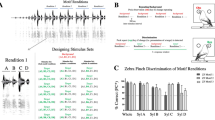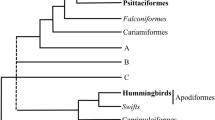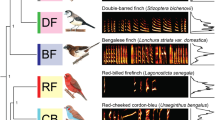Abstract
A RECENT article by W. H. T.1 reviewed the general question of the perceptual basis for group organization by birds and other vertebrates. It pointed out that successful social organization of colonially nesting sea birds must in many cases depend on a capacity for mutual recognition at some distance, at least between mates and oalso between parents and young, perhaps extending to other members of the group. While many species of birds (such as gulls and ducks) have visual powers so acute that they are able to recognize individuals at distances of 50 m or more, it was nevertheless shown that auditory recognition of individuals by subtle voice characteristics also plays a part—sometimes major—in identification. Indeed, in some examples of gulls, penguins, auks and terns, the evidence suggests that audiovocal recognition is likely to be more effective in the difficult conditions of life in a dense breeding colony than is visual recognition. As an example, work on the sandwich tern (Sterna sandvicensis)2 has shown in some detail that the individual vocal patterns are constant and can be distinctively categorized in terms of a pattern of energy distribution expressed as frequency against time, which is so well shown by the spectrograph. This kind of pattern is, of course, what we ourselves hear as organized sounds with their characteristic temporal arrangement and tonal quality, as in speech or music.
This is a preview of subscription content, access via your institution
Access options
Subscribe to this journal
Receive 51 print issues and online access
$199.00 per year
only $3.90 per issue
Buy this article
- Purchase on Springer Link
- Instant access to full article PDF
Prices may be subject to local taxes which are calculated during checkout
Similar content being viewed by others
References
Thorpe, W. H., Nature, 220, 124 (1968).
Hutchison, R. E., Stevenson, J. G., and Thorpe, W. H., Behaviour, 32, 150 (1968).
White, Sheila J., and White, R. E. C., Behaviour (in the press).
Licklider, J. C. R., and Miller, G. A., in Handbook of Experimental Psychology (edit. by Stevens, S. S.), 1040 (Wiley, New York, 1951).
Pruzansky, Sandra, J. Acoust. Soc. Amer., 58, 354 (1963).
Schwartzkopff, J., Fortschr. Zool., 12, 206 (1960).
Author information
Authors and Affiliations
Rights and permissions
About this article
Cite this article
WHITE, S., WHITE, R. & THORPE, W. Acoustic Basis for Individual Recognition by Voice in the Gannet. Nature 225, 1156–1158 (1970). https://doi.org/10.1038/2251156a0
Received:
Issue Date:
DOI: https://doi.org/10.1038/2251156a0
This article is cited by
-
Cues to individual identity in songs of songbirds: testing general song characteristics in Chiffchaffs Phylloscopus collybita
Journal of Ornithology (2017)
-
Facial and Vocal Individual Recognition in the Common Chimpanzee
The Psychological Record (1983)
Comments
By submitting a comment you agree to abide by our Terms and Community Guidelines. If you find something abusive or that does not comply with our terms or guidelines please flag it as inappropriate.



